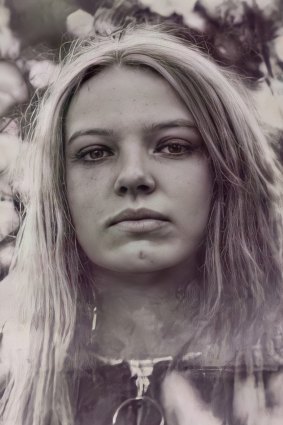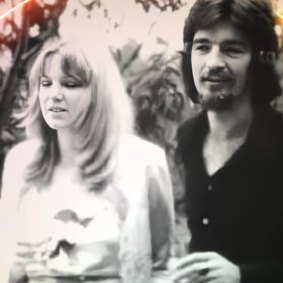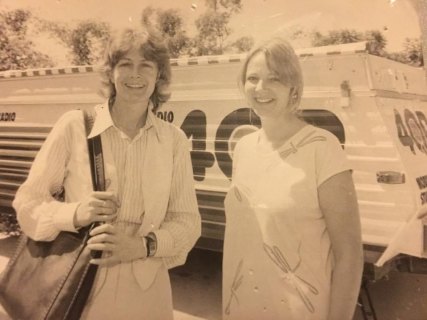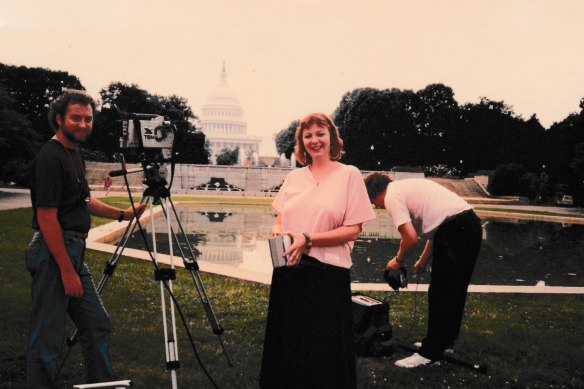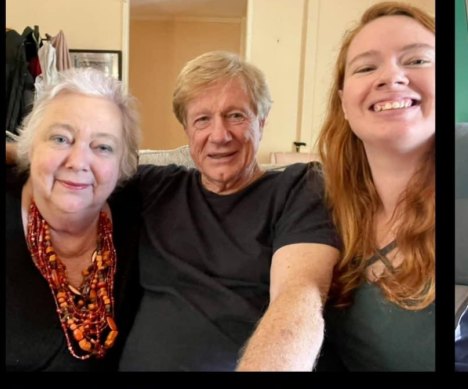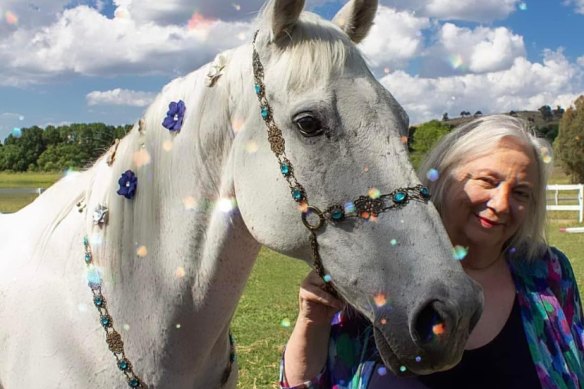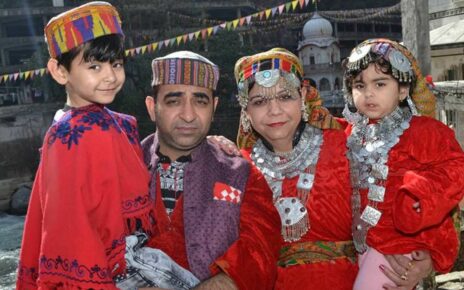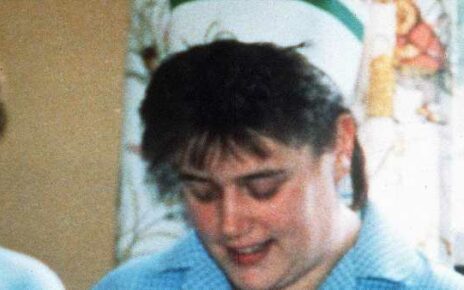Save articles for later
Add articles to your saved list and come back to them any time.
Current affairs television, to its audience, can be little more than a series of familiar faces of presenters, prejudices about their presentation style, satisfaction or rage about the way stories are presented.
This overlooks the reality of how such television is made – and the huge cast of people putting their journalistic and creative talents into what the audience sees.
Patricia Barraclough and daughter Jess.
The people you may know the least about are often the engine room of a television program: the producers who bring to their jobs everything from intellectual rigour and story ideas to logistics-wrangling skills that would be gratefully accepted in a disaster zone.
In a career that stretched more than 40 years, Patricia Barraclough – who died in Canberra last month – elevated the quality and intelligence of some of ABC television’s most successful current affairs programs, from This Day Tonight to Lateline, from Australian Story to Stateline.
Patricia Barraclough in her earlier years.
These were programs that broke new ground and Trisha Barraclough, according to those who worked with her, was integral to laying the foundations of those programs and setting the templates for how they told their stories.
The Barraclough constant through all this change was an intolerance for bullshit, a particular desire to tell stories of people doing it tough in life, but always seeking to make the stories visually beautiful and intellectually rich.
Patricia Mary Barraclough was born on September 5, 1951 in Surrey, England to Edward and Mary Barraclough (nee Dennis). She was their second child and only daughter and grew up with three brothers, Michael, Philip and Richard.
The family migrated to Australia in the early 1950s, following Trisha’s father’s work as a research chemist.
They lived in Melbourne, Sydney and, later in life, in Canberra, where Trisha’s mother Mary – after the death of her husband – built a new life working at the Australian National University and as one of the first guides at the National Gallery of Australia.
“Hippy bride” Trish Barraclough and husband Warwick Konopacki on their wedding day.
Trisha was educated in Melbourne by the nuns at Sacre Coeur in Glen Iris where, according to her brothers, her naturally rebellious streak was already on show.
In 1969, she moved to Sydney and Macquarie University just as the social revolution of the late 1960s and 1970s was erupting, and quickly became involved with causes of the day like the Vietnam Moratorium movement and some of the notable radical figures of the day: Pierre Vicary, Calvin Noack, Mark Aarons and Phil Gibbs.
While living in student digs in Balmain in 1972, she met Warwick Konopacki, who was studying to be a clinical psychologist. They married in 1974 in the family living room, with Barraclough a barefoot hippy bride.
By this time, she had started work as a researcher at the Sydney headquarters of ABC television at Gore Hill. They drove to Queensland for their honeymoon but only got as far as Brisbane. They stayed, living on a small acreage – one of her first opportunities to indulge a lifelong love of horses.
A committed feminist, she volunteered at the early rape crisis centre and women’s shelter established in Brisbane. Her activism brought her into contact with a rich array of people – author, poet and essayist Kate Jennings was a lifelong friend. Memorably, she once spent several says steering a rather lost Vanessa Redgrave around Brisbane after making an instant connection with the legendary actor.
Kindred spirits: Trish Barraclough with Vanessa Redgrave.
Trisha was a great booster for all her colleagues, but particularly young women journalists (including this one). Being a woman was not ever going to impede your professional life, as far as she was concerned.
In 1976, she started working in Brisbane with Maxine McKew and Andrew Olle on This Day Tonight. McKew and Barraclough were the only women working in what McKew describes as “a casually sexist environment but huge, huge fun”.
“All the blokes said: ‘They’ll never get on.’ And on the face of it, it seemed unlikely: Trisha, in her flowing cheesecloth top, jeans tucked into take-no-prisoners boots, looked like a less wrecked Marianne Faithfull. Me? I was channelling Peggy in Mad Men,” McKew recalls.
“She had a sharp mind, a finely tuned aesthetic, and the invaluable journalistic asset of a great bullshit detector. She was usually five steps ahead of you and of her executive producers. She loved fighting for her ground.”
Lights, camera … Trish Barraclough on location.
Barraclough went on to run her own programs as an executive producer of radio in Brisbane.
After parting with Konopacki, she started working at the ABC in Canberra. In her early 40s, she found herself surprised and delighted to be contemplating single motherhood with the birth of her beloved daughter, Jess, on November 13, 1991.
The previous year, she had begun a great journalistic collaboration as Canberra producer for Kerry O’Brien on a new nightly current affairs program, Lateline, which drew guests from every corner of the globe via satellite, many of them giants in their field. Guests like Nelson Mandela, Mikhail Gorbachev and Margaret Thatcher.
O’Brien recalls: “I presented the program from a small ABC studio in Canberra’s Parliament House. Trisha was my producer, and combining the Sydney and Canberra output while delivering guests live from around the world, was always technically fraught.
Kerry O’Brien presenting the ABC’s Lateline in 1991.Credit: ABC
“Some nights, as the opening theme would start playing, we sat in the studio not knowing whether all the guests from three different time zones had arrived or their pictures would be delivered or their sound linked in time.
“For the first six years, as we moulded the show and built an audience, Trisha was always at the heart of the process, and put her own special stamp on so many programs. Where she came into her own was in generating ideas beyond the program’s bread and butter – politics, economics and the big international stories.
“She had a great capacity to think outside the square and an eye for strong social issues and the arts, and she challenged us all to broaden the dimension of the show. She was a perfect foil for me, never allowing me to get too serious.
“Without her influence in those first critical years, I don’t believe Lateline would have had quite the breadth or the capacity to surprise that made it special. She certainly brought out the best in me, and everyone else around her.”
In 1995, she moved from Lateline to the birth of another innovative program, Australian Story, working in Brisbane.
To many of her colleagues, the Australian Story format was peak Barraclough: it was about the person, not the journalists. She had an extraordinary capacity to persuade people to trust the program with their stories.
Founding executive producer, Deb Fleming says: “Demonstrably, that program would never have happened without her.”
“It’s a small tragedy that she put in all the hard yards, but escaped home to Canberra without ever benefiting from the awards and accolades that followed over the next ten years.”
Trish with daughter Jess and godparent Kerry O’Brien.
After returning to Canberra, Barraclough would go on to be the founding executive producer of the ACT edition of Stateline – the only time Canberra had its own current affairs program.
Veteran ABC reporter Phil Williams remembers working with her as “the happiest period of my career” and her passion for “people-oriented stories and beautiful pictures and music”.
“We used to win the ratings on a Friday night, which no other Stateline did … we didn’t have to do a lot of state politics and corruption. Patricia gave us a lot more freedom, though she would go hard on a political story when needed,” he says.
Barraclough very much drove the push to deal with the legacy of Mr Fluffy: the business that pumped loose asbestos fibre into the ceilings of houses all over Canberra in the 1970s, leaving a deadly legacy of deaths and contaminated homes well into the current century. When the program was dumped in 2014, she was shattered for herself, her team and the community that loved it.
Her long career at the ABC came to an end, and she retreated into seclusion for some years to Murrumbateman, outside Canberra, where she lived with Jess, her horses, dogs and cats and, in recent times, orphaned wildlife.
It was a good time for the intensely tight Trish and Jess duo though: Trisha helped Jess finish her zoology degree and they travelled regularly together to NSW’s South and North Coasts, enjoying each other’s company.
Trish with one of her beloved horses.
It would be her love of photography and becoming a warrior in defence of journalism and decent politics on Twitter and Facebook that eventually brought her back among her friends.
She was diagnosed with lung cancer in 2022 and subjected herself to every form of treatment to resist its spread. The tough side effects of the treatment were offset by the considerable joy she got from reconnecting with people – those she had not seen for years, some whom she had never met before.
She died at Clare Holland House in the early afternoon on November 21, with her beloved Jess and brother Richard by her side.
Start the day with a summary of the day’s most important and interesting stories, analysis and insights. Sign up for our Morning Edition newsletter.
Most Viewed in National
From our partners
Source: Read Full Article

